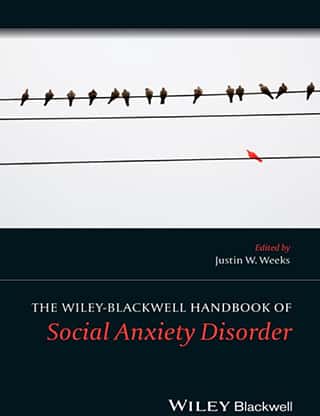I dagarna kommer en bibel ut för den som vill ha en ökad förståelse för uppkomst och vidmakthållande av social fobi. Boken, som förstås även innehåller mycket kring behandling, heter “The Wiley Blackwell Handbook of Social Anxiety Disorder“. Det är en editerad bok med Justin W. Weeks som redaktör. Tyvärr är den svindyr (vilket är bisarrt eftersom man som författare inte får ett öre). Förhoppningsvis går det att låna den på bibliotek! Boken, vars officiella utgivningsdatum är den 28 april, består av 27 kapitel som täcker näst intill varje aspekt av social fobi. Vårt kapitel redogör för internetbaserad behandling av just social fobi. Vi tar exempelvis upp historiken, beskriver olika internetbaserade program (David M Clark har ju exempelvis numera ett eget program) och dess effektivitet både på kort och lång sikt, etiska och säkerhetsmässiga aspekter, hur viktig terapeuten är och vad som förklarar olika behandlingsutfall.
Referens: Andersson, G., Carlbring, P. and Furmark, T. (2014) Internet-Delivered Treatments for Social Anxiety Disorder, in The Wiley Blackwell Handbook of Social Anxiety Disorder (ed J. W. Weeks), John Wiley & Sons, Ltd, Chichester, UK. [doi: 10.1002/9781118653920.ch26]
Bokkapitel:
- Cognitive-Behavioral Models of Social Anxiety Disorder (pages 1–23)
- Evolutionary Models: Practical and Conceptual Utility for the Treatment and Study of Social Anxiety Disorder (pages 24–52)
- Genetic Factors in Social Anxiety Disorder (pages 53–66)
- The Social Neuroscience of Social Anxiety Disorder (pages 67–89)
- The Pathophysiology of Social Anxiety (pages 90–110)
- Personality: Understanding the Socially Anxious Temperament (pages 111–132)
- Behavioral Inhibition: A Discrete Precursor to Social Anxiety Disorder? (pages 133–158)
- Relational Processes in Social Anxiety Disorder (pages 159–178)
- Social Anxiety Disorder in Children and Adolescents (pages 179–200)
- Comorbidity: Social Anxiety Disorder and Psychiatric Comorbidity are not Shy to Co-Occur (pages 201–222)
- Diversity Considerations in the Assessment and Treatment of Social Anxiety Disorder (pages 223–246)
- Heterogeneity Within Social Anxiety Disorder (pages 247–267)
- Clinical Interviews: Empirical Overview and Procedural Recommendations (pages 269–291)
- Self-Report Assessment: The Status of the Field and Room for Improvement (pages 292–319)
- Cognitive Biases among Individuals with Social Anxiety (pages 321–343)
- Behavioral Deviations: Surface Features of Social Anxiety and What they Reveal (pages 344–365)
- Examining the Controversy Surrounding Social Skills in Social Anxiety Disorder: The State of the Literature (pages 366–387)
- Translational Research in Social Anxiety: Summary of Newest Developments and Future Directions (pages 389–408)
- Positivity Impairment as a Broad-Based Feature of Social Anxiety (pages 409–432)
- Fear of Positive Evaluation: The Neglected Fear Domain in Social Anxiety (pages 433–453)
- The Neuroendocrinology of Social Anxiety Disorder (pages 454–474)
- Cognitive-Behavioral Therapy for Social Anxiety Disorder: The State of the Science (pages 475–497)
- Cognitive-Behavioral Therapy for Social Anxiety Disorder: Applying the Approach (pages 498–520)
- Pharmacological Treatment for Social Anxiety Disorder (pages 521–546)
- Dual Diagnosis Cases: Treating Comorbid Social Anxiety Disorder and Substance Abuse or Dependence (pages 547–568)
- Internet-Delivered Treatments for Social Anxiety Disorder (pages 579–587)
- Acceptance and Mindfulness-Based Therapies for Social Anxiety Disorder: Current Findings and Future Directions (pages 588–607)
[lightbox link=”http://www.carlbring.se/wp/wp-content/uploads/2014/03/SAD_CHAP_26_Weeks.jpg” thumb=”http://www.carlbring.se/wp/wp-content/uploads/2014/03/SAD_CHAP_26_Weeks-725×1024.jpg” width=”725″ align=”center” title=”SAD_CHAP_26_Weeks” frame=”true” icon=”image”]
